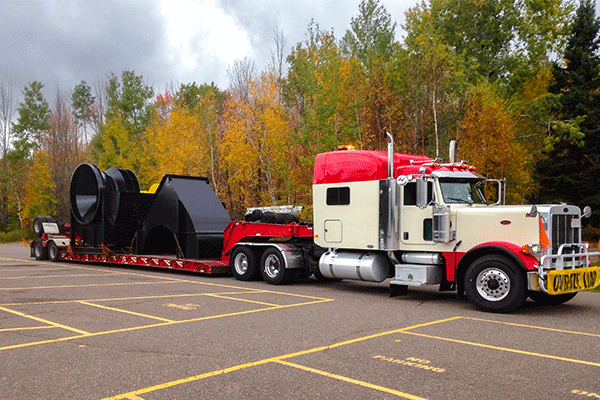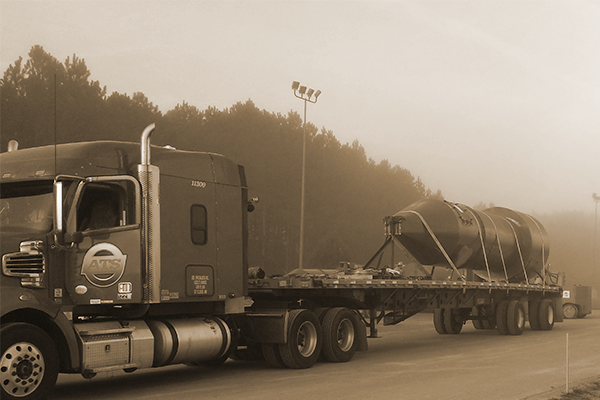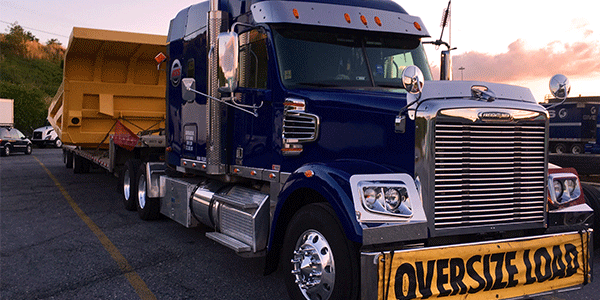Key Takeaways:
- Most cross-border freight is transported via through-trailer service or transloading.
- Through-trailer is best for over-dimensional and high-value freight.
- Transloading is best for flexibility and remote destinations within Mexico.
- Choosing the right transportation provider and customs broker is critical to properly coordinating cross-border movements.
- Mind the insurance gap: U.S. coverage stops at the border.
Even those of us who have shipped cross-border before can find the process daunting. From the specific shipping services themselves to the customs requirements to the documentation, U.S.-Mexico shipping is layered with complexity.
For your cross-border shipment to go as planned, understanding these nuances is key. We know this firsthand at Anderson Trucking Service (ATS), as we’ve operated within Mexico for decades and helped countless customers navigate U.S.-Mexico shipments with confidence.
In this blog, we’ll break down the basics of U.S.-Mexico cross-border shipping, including:
- The two main service types you’ll encounter
- What to look for in a cross-border transportation provider
- The role of customs brokers
- The documentation you'll need to ensure smooth transport
- How cargo coverage differs in the U.S. vs. Mexico
You’ll walk away with a strong foundation of knowledge to help guide your cross-border shipment planning in the future. Let’s get started!
Cross-Border Shipping Services
The first step on your journey to move freight into and out of Mexico is determining which type of cross-border service your situation requires.
If your freight is traveling over the road, your primary options for cross-border shipping are through-trailer service and transloading.
Each of these services comes with a unique set of pros, cons, and best use scenarios. Understanding the strengths and weaknesses of both service types and comparing them to your needs will help you determine which one is right for your freight.
What is Through-Trailer Service?
Through-trailer service moves your freight across (or “through”) the border without transferring it off its original trailer.
When shipping via through-trailer service, cargo will still be inspected, but it will not change trailers during that process or at any other time in its journey. As such, through-trailer service is considered an excellent way to prevent cargo damage or during loading/unloading.
However, that doesn’t mean that one driver will haul your shipment on both sides of the border. While your freight remains in its trailer, that trailer may change tractors — and therefore drivers — up to two times during its cross-border transit.
That means as many as three drivers may haul your cross-border shipment. Each is responsible for a specific stretch of its journey. For a U.S.-to-Mexico shipment, those responsibilities break down like this:
- U.S.-based drivers are employed by an American freight carrier and are responsible for the U.S. leg of your shipment’s transportation.
- Crossing drivers then take your freight through customs and across the border. These drivers typically specialize in the border-crossing process.
- Mexico-based drivers are employed by the forwarding partner of your U.S.-based provider and are responsible for the Mexican leg of your shipment’s transportation. They receive your shipment from the crossing driver, often at a secure trailer yard near the border, and transport it to its final destination in Mexico.
For a Mexico-to-U.S. shipment, these responsibilities stay essentially the same, but with inverted origin and destination points.
Through-trailer service requires all drivers/carriers involved to have a trailer interchange agreement between the U.S. and Mexico. A trailer interchange agreement is a type of contract that allows trailers to change hands from one driver to another and clearly states the liability of each party.
Due to this requirement, through-trailer service capacity in Mexico is typically harder to find (especially for more remote locations) than transloading capacity.
When to Use Through-Trailer Service
Through-trailer service is best utilized when your shipment is either over-dimensional (OD) or high-value.
In the case of OD freight, through-trailer service is just plain easier, as it eliminates the need to transfer overly heavy, wide, tall, or long freight from one trailer to the next.
When transporting high-value freight, the fewer transfers, the better. Reducing the need to handle the freight helps to prevent damage and theft while in transit.
Through-trailer is also often the best option for freight that needs to move:
- Urgently
- Within Mexico
- To an easily accessible destination
This is because the alternative option — transloading — requires freight to stop moving for a half or full day so it can be transferred to another trailer.
If urgency is a priority, remember that through-trailer capacity in Mexico can be harder to find than transloading capacity, which may mean it takes longer for your transportation provider to procure.
And speaking of urgency: as with any transportation service, it’s important to give your provider a minimum of 2-3 days’ notice before any cross-border shipments need to move. The more complex your needs, the more lead time you should provide.
Giving your provider an ample amount of lead time will help them find you the best solution at a competitive price.
What is Transloading?
Transloading is a logistics service with two associated definitions:
- The transferring of goods from one transportation mode (land, air, ocean, or rail) to another.
- The unloading of a shipment from one trailer and re-loading on another with little or no storage in between. It may also include the removal of items from pallets, sorting parts for various destinations, and repackaging.
For the purposes of this article, we’re focusing on the second definition. Also called cross-docking, transloading differs from through-trailer service because it involves multiple trailers.
The way transloaded U.S.-to-Mexico freight travels is actually very similar to through-trailer freight:
- A U.S.-based driver takes the freight to the border
- A crossing driver takes the freight over the border
- A Mexico-based driver takes the freight to its final destination
The only difference is that transloaded freight begins its journey on one trailer and concludes it on another.
At the midpoint of its transit, transloaded freight stops (typically at a secure trailer yard near the border) and is transferred to another trailer to complete the second half of its travel.
When to Use Transloading
Transloading tends to be a great fit for any pallet-based, easily unloadable freight, as well as any freight that needs to go to more remote areas within Mexico.
The transloading process, which relies on quick loading and unloading, is naturally better suited to palletized freight than, say, breakbulk or OD shipments.
It’s also a great option for freight headed to less accessible regions in Mexico, as transloading does not require the same trailer interchange agreements and is therefore offered by a broader carrier network.
That means that, in general, you’re more likely to find coverage for a load going to a remote destination (where backhauls are scarce) if you are transloading rather than utilizing through-trailer service.
Transloading may also deliver cost efficiencies. While the act of transloading typically adds time to a shipment, it can be more cost-effective than through-trailer service.
This is because smaller trucking companies will often transload freight simply because they don’t have the trailer capacity to support through-trailer service.
In these instances, the access to a greater pool of transloading providers (and therefore more options and a more competitive market) can offer both shippers and carriers the opportunity to save.
While these are compelling benefits, transloading does have its downsides. Chief among them is an increased risk of damage, loss, and delays due to increased handling.
As such, if your freight is high-value or particularly susceptible to damage, you may through-trailer service to be worth the potentially higher price tag instead.
What to Look for In a Cross-Border Transportation Provider
Due to the inherently fragmented nature of cross-border transportation in general, having an experienced transportation provider to oversee the transit as a whole and communicate across all parties is critical.
Look for transportation providers with a proven track record of successful cross-border shipments and projects. Some specialize in cross-border logistics, while others handle cross-border as part of a larger suite of over-the-road or international services.
It’s also important to note that not all transportation providers are certified customs brokers. While this isn’t a reason not to work with a provider, it is something you’ll want to understand thoroughly before proceeding, as your customs requirements may be handled by a third-party broker.
The Role of Customs Brokers
Customs brokers are a third party employed by the shipper to handle customs compliance for cross-border and international shipments. All customs brokers must be certified by the U.S. Department of Customs and Border Protection (CBP) before they can legally work with shippers.
Customs brokers are responsible for:
- Ensuring compliance with all applicable customs laws, regulations, etc.
- Ensuring goods meet all legal requirements to clear customs
- Preparing and submitting any necessary paperwork
- Calculating and ensuring the proper payment of any applicable customs duties, taxes, and fees
- Acting as a point of contact between the shipper, transportation providers, and customs authorities on both sides of the border
As such, a customs broker is an integral piece in getting your shipment across the border safely and efficiently. Although it’s the shipper’s duty to vet and choose a customs broker for their shipments, many lean on the recommendations of their U.S.-based transportation provider.
Transportation providers experienced in cross-border and international shipments will be able to point you toward one or more certified customs brokers they work with and trust.
Shippers can also leverage the CBP’s searchable Permitted Customs Brokers Listing page to find certified customs brokers in their area, or to check the certification status of a customs broker already on their radar.
Ultimately, shippers should look for customs brokers that have:
- Active, valid certification
- Longevity in the industry
- A proven track record of success
- Positive reviews by shippers
- Experience brokering customs requirements for similar freight/lanes, if possible
- Earned the recommendation of one or more experienced transportation providers
If a customs broker can check all of these boxes, they’re likely a strong contender for addition to your network.
Cross-Border Shipment Documentation
The second a shipment needs to move anywhere beyond the contiguous 48 states, it becomes a more complex — and paperwork-heavy — affair.
Cross-border shipping between the U.S. and Mexico is no different. The good news is that most of these documents are the responsibility of your transportation provider and customs broker.
Still, there is some documentation that will be your responsibility to provide (though a good transportation provider will guide you and be a resource should you have any questions), and it’s good to understand what all is required before your freight can move.
To that end, here’s a list of documentation necessary to ensure the smooth, legal travel of your cross-border shipment:
- Bill of Lading
- Shipper’s Letter of Instructions (SLI)
- Documento de Operación para Despacho Aduanero (DODA), a customs document specific for goods entering or leaving Mexico
- Canceled bond, which indicates that all obligations related to an in-bond shipment have been met
- Cargo manifest
- Carta Porte, a mandatory tax document in Mexico
- Carta Porte signed by the receiver
For a deeper dive into these documents and others needed for international shipments (including those traveling by air or ocean transport), check out our article on The Documents You Need for International Shipping Success.
Cross-Border Cargo Insurance Coverage
Cargo coverage for U.S.-Mexico cross-border freight has frustrated many a shipper, namely because the countries do not handle carrier liability the same way.
Our article U.S. vs. Mexico Cargo Insurance: Key Coverage Differences Explained gets into all the nitty gritty details of each country’s regulations, but to sum it all up:
- Your cargo coverage will not continue after your freight crosses into Mexico.
- Most shippers will need to pursue additional insurance for their shipment to bridge the coverage gap, especially if their goods are high-value or OD.
- Securing additional coverage is your responsibility as the shipper, though your U.S.-based transportation provider should be able to direct you reputable agencies that offer cross-border freight insurance.
The bottom line is that it’s in your (and your bottom line’s) best interest to fully understand the differences in cargo coverage and carrier liability requirements between the U.S. and Mexico before moving any freight over the border.
Doing so — and pursuing any additional coverage accordingly — will help prevent coverage gaps that could lead to costly losses in the case of damage in transit.
Confident Cross-Border Shipping Starts with Understanding
Shipping freight between the U.S. and Mexico doesn’t have to feel like a high stakes guessing game. By understanding the two primary service and the unique benefits and trade-offs of each, you’re better equipped to select the right method for your freight’s needs.
Knowing what to look for in a transportation provider, how customs brokers fit into the equation, which documents are required, and how cargo coverage changes at the border all further strengthen your ability to plan effectively and avoid costly missteps.
Armed with this knowledge, you can make informed, confident decisions that help keep your cross-border shipments on track — even when challenges arise.
Want to take your understanding a step further? Learn how in-bond shipments fit into the U.S.-Mexico shipping landscape by reading Bonded Shipments: What to Know About Transporting Freight In-Bond.






